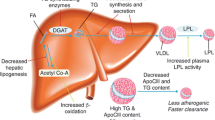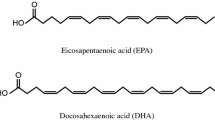Abstract
Elevated levels of triglycerides are associated with pancreatitis and an increased risk of coronary heart disease. Numerous pharmacologic therapies are available to treat hypertriglyceridemia, including prescription omega-3 fatty acids, which reduce triglyceride levels by 20–50%. Available data indicate the omega-3 fatty acids eicosapentaenoic acid (EPA) and docosahexaenoic acid (DHA) may be beneficial for secondary prevention of coronary heart disease. Products containing DHA may increase low-density lipoprotein cholesterol (LDL-C) and, subsequently, coronary heart disease risk. We reviewed prescription omega-3 fatty acid products, of which two—omega-3 acid ethyl esters (OM3EE) and omega-3 carboxylic acid (OM3CA)—contain both DHA and EPA, whereas the other—icosapent ethyl (IPE)—contains EPA only. We identified three retrospective chart reviews and three case reports comparing IPE with OM3EE, whereas two studies compared IPE with placebo. We also reviewed the major studies of OM3EE versus placebo used to gain US FDA approval. LDL-C levels decreased or did not increase significantly in all available studies and case reports in patients receiving the IPE product, with the best data supporting a dose of 4 g per day. The majority of studies only included patients taking IPE concomitantly with statins, but limited data from one study using IPE monotherapy showed a small reduction in LDL-C. Many questions remain regarding IPE, including whether the product reduces cardiovascular events and mortality.
Similar content being viewed by others
References
Cohen JD, Cziraky MJ, Cai Q, Wallace A, Wasser T, Crouse JR, Jacobson TA. 30-Year trends in serum lipids among United States adults: results from the National Health and Nutrition Examination Surveys II, III, and 1999–2006 [published correction appears in Am J Cardiol. 2010;106:1826]. Am J Cardiol. 2010;106:969–75.
Miller M, Stone NJ, Ballantyne C, Bittner V, Criqui MH, Ginsberg HN, et al. Triglycerides and cardiovascular disease: a scientific statement from the American Heart Association. Circulation. 2011;123:2292–333. https://doi.org/10.1161/CIR.0b013e3182160726.
Stone NJ, Robinson JG, Lichtenstein AH, et al. 2013 ACC/AHA guideline on the treatment of blood cholesterol to reduce atherosclerotic cardiovascular risk in adults: a report of the American College of Cardiology/American Heart Association task force on practice guidelines. Circulation. 2014;129:S1–45.
Ito MK. A comparative overview of prescription omega-3 fatty acid products. P T. 2015;40(12):826–36.
Siscovick DS, Barringer TA, Fretts AM, et al. Omega-3 polyunsaturated fatty acid (fish oil) supplementation and the prevention of clinical cardiovascular disease: a science advisory from the American Heart Association. Circulation. 2017;135:e867–84. https://doi.org/10.1161/CIR.0000000000000482.
Lovaza® [package insert]. GlaxoSmithKline, Inc., Research Triangle Park, NC, USA; 2015.
Omtryg®[package insert]. Trygg Pharma, Inc., Arlington, VA, USA; 2016.
Brinton EA, Mason RP. Prescription omega-3 fatty acid products containing highly purified eicosapentaenoic acid (EPA). Lipids Health Dis. 2017;16(23):1–13. https://doi.org/10.1186/s12944-017-0415-8.
Jacobson TA, Glickstein SB, Rowe JD, et al. Effects of eicosapentaenoic acid and docosahexaenoic acid on low-density lipoprotein cholesterol and other lipids: a review. J Clin Lipidol. 2012;6(1):5–18. https://doi.org/10.1016/j.jacl.2011.10.018.
Ballantyne CM, Bays HE, Kastelein JJ, et al. Efficacy and safety of eicosapentaenoic acid ethyl ester (AMR101) therapy in statin-treated patients with persistent high triglycerides (from the ANCHOR study). Am J Cardiol. 2012;110:984–92. https://doi.org/10.1016/j.amjcard.2012.05.031.
Bays HE, Ballantyne CM, Kastelein JJ, Isaacsohn JL, Braeckman RA, Soni PN. Eicosapentaenoic acid ethyl ester (AMR101) therapy in patients with very high triglyceride levels (from the multi-center, placebo-controlled, randomized, double-blind, 12-week study with an open-label extension [MARINE] trial. Am J Cardiol. 2011;108:682–90. https://doi.org/10.1016/j.amjcard.2011.04.015.
Davidson MH, Stein EA, Bays HE, et al. Efficacy and tolerability of adding prescription omega-3 fatty acids 4 g/d to simvastatin 40 mg/d in hypertriglyceridemic patients: an 8-week, randomized, double-blind, placebo-controlled study. Clin Ther. 2007;29(7):1354–67. https://doi.org/10.1016/j.clinthera.2007.07.018.
Maki KC, Orloff DG, Nicholls SJ, et al. A highly bioavailable omega-3 free fatty acid formulation improves the cardiovascular risk profile in high-risk, statin-treated patients with residual hypertriglyceridemia (the ESPRIT trial). Clin Ther. 2013;35(9):1400–11. https://doi.org/10.1016/j.clinthera.2013.07.420.
Kastelein JJP, Maki KC, Susekov A, et al. Omega-3 free fatty acids for the treatment of severe hypertriglyceridemia: the epanova for lowering very high triglycerides (EVOLVE) trial. J Clin Lipidol. 2014;8:94–106. https://doi.org/10.1016/j.jacl.2013.10.003.
Harris WS, Ginsberg HN, Arunakul N, et al. Safety and efficacy of omacor in severe hypertricglyceridemia. J Cardiovasc Risk. 1997;4:385–91.
Pownall HJ, Brauchi D, Kilinc C, et al. Correlation of serum triglyceride and its reduction by omega-3 fatty acids with lipid transfer activity and the neutral lipid composition of high-density and low-density lipoproteins. Atherosclerosis. 1999;143:275–84.
Hassan A, Tajuddin N, Shaikh A. Retrospective case series of patients with diabetes or prediabetes who were switched from omega-3-acid ethyl esters to icosapent ethyl. Cardiol Ther. 2015;4:83–93. https://doi.org/10.1007/s40119-014-0032-9.
Crandell JR, Tartaglia C, Tartaglia J. Lipid effects of switching from prescription EPA + DHA (omega-3-acid ethyl esters) to prescription EPA only (icosapent ethyl) in dyslipidemic patients. Postgrad Med. 2016;128(8):859–64. https://doi.org/10.1080/00325481.2016.1241129.
Castaldo RS. A retrospective case series of the lipid effects of switching from omega-3 fatty acid ethyl esters to icosapent ethyl in hyperlipidemic patients. Postgrad Med. 2014;126(3):268–73.
Kedia AW, Lynch E. Effects of switching from omega-3-acid ethyl esters to icosapent ethyl in a statin-treated patient with elevated triglycerides. Postgrad Med. 2015;127(8):869–73. https://doi.org/10.1080/00325481.2015.1100086.
Crandell JR. Switching from EPA + DHA (omega-3-acid ethyl esters) to high-purity EPA (icosapent ethyl) in a statin-treated patient with persistent dyslipidemia and high cardiovascular risk: a case study. Clin Med Insights Cardiol. 2016;10:123–8.
Hilleman DE, Malesker MA. Potential benefits of icosapent ethyl on the lipid profile: case studies. Clin Med Insights Cardiol. 2014;8:13–5.
Yokoyama M, Origasa H, Matsuzaki M, et al. Effects of eicosapentaenoic acid on major coronary events in hypercholesterolaemic patients (JELIS): a randomized open-label, blinded endpoint analysis. Lancet. 2007;369:1090–8. https://doi.org/10.1016/S0140-6736(07)60527-3.
Suzukawa M, Abbey M, Howe PRC, Nestel PJ. Effects of fish oil fatty acids on low density lipoprotein size, oxidizability, and uptake by macrophages. J Lipid Res. 1995;36:473–84.
Mori TA, Burke V, Puddey IB, et al. Purified eicosapentaenoic and docosahexanoic acids have differential effects on serum lipids and lipoproteins, LDL particle size, glucose, and insulin in mildly hyperlipidemic men. Am J Clin Nutr. 2000;71:1085–94.
Tholstrup T, Hellgren LI, Petersen M, et al. A solid dietary fat containing fish oil redistributes lipoprotein subclasses without increasing oxidative stress in men. J Nutr. 2004;134:1051–7.
Bowen KJ, Harris WS, Kris-Etherton PM. Omega-3 fatty acids and cardiovascular disease: are there benefits? Curr Treat Options Cardio Med. 2016;18(69):1–16. https://doi.org/10.1007/s11936-016-0487-1.
Walz CP, Barry AR, Koshman SL. Omega-3 polyunsaturated fatty acid supplementation in the prevention of cardiovascular disease. Can. Pharm. J. 2016;149(3):166–73. https://doi.org/10.1177/1715163516640812.
Jump DB, Depner CM, Tripathy S. Omega-3 fatty acid supplementation and cardiovascular disease. J Lipid Res. 2012;53:2525–45. https://doi.org/10.1194/jlr.R027904.
Vascepa® [package insert]. Amarin Pharmaceuticals, Inc., Bedminster, NJ, USA; 2012.
Shannon R, John S, Ferrera J, Best S, Allen SN. Statin-associated myopathy. US Pharm. 2012;37(2):55–9.
Amarin (2017) Amarin announces publication of REDUCE-IT cardiovascular outcomes study rationale and design in clinical cardiology. http://investor.amarincorp.com/releasedetail.cfm?releaseid=1017519. Accessed 26 Oct 2017.
Author information
Authors and Affiliations
Corresponding author
Ethics declarations
Conflicts of interest
Randall P. Sharp, Barry J. Gales, and Riaz Sirajuddin have no conflicts of interest.
Funding
No sources of funding were used to assist with the preparation of this review.
Rights and permissions
About this article
Cite this article
Sharp, R.P., Gales, B.J. & Sirajuddin, R. Comparing the Impact of Prescription Omega-3 Fatty Acid Products on Low-Density Lipoprotein Cholesterol. Am J Cardiovasc Drugs 18, 83–92 (2018). https://doi.org/10.1007/s40256-017-0253-0
Published:
Issue Date:
DOI: https://doi.org/10.1007/s40256-017-0253-0




